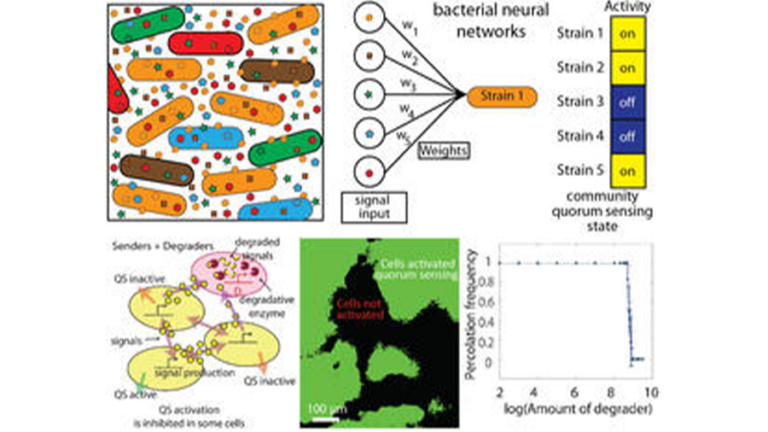Bacterial communication networks
Bacteria communicate through the exchange of signaling molecules. Signal exchange coordinates the behavior of bacterial populations in a process known as quorum sensing. Within diverse bacterial communities, many types of molecular signals are exchanged resulting in crosstalk between species. Some species can even interfere with cellular communication through destruction or chemical modification of signaling moelcules. Our group explores the consequences of such intereference and crosstalk on the ability of cellular communication networks to coordinate activity within large and diverse bacterial communities.

Vesicle-mediated gene transfer
Microorganisms possess complex abilities to transfer genetic material through horizontal gene transfer, fundamentally shaping genetic landscapes and affecting biological functions. The capacity for DNA exchange in bacteria and the plasticity of their genetic material has amplified the rate of adaptation and evolution within microbial ecosystems. Within heterogeneous populations, DNA transfer occurs between different species of bacteria. Traditionally, gene transfer is thought to occur via three mechanisms: transformation, conjugation, and transduction. However the ability of membrane vesicles released by bacteria to facilitate gene exchange has recently been reported. Nearly all observed bacteria, including both Gram-negative and Gram-positive bacteria, secrete membrane vesicles. Our work has characterized the ability of bacteria to exchange genes within vesicles, identifying the biological parameters that determine which species transfer DNA and the rate of exchange. Our results suggest that although gene exchange in vesicles is slow, it is both promiscuous and common and therefore plays an important role in gene transfer within microbial ecosystems.

Biogenic synthesis of nanomaterials
Microbes have the natural ability to process many metallic and semiconductor materials using redox enzymes. We engineer synthetic cellular factories that use multiple reduction pathways to create nanomaterials, such as arsenic sulfide nanowires and cadmium sulfide nanospheres. Using the tools of synthetic biology, we explore how the properties of these materials can be tuned by adjusting biological parameters such as gene expression dynamics and host species. The long term goal is to build communities of microorganisms capable of synthesizing complex nanomaterials.

Pattern formation and collective behavior of wild microbes
Large populations of bacteria often self-organize into macroscale patterns of high and low cell density that result in elaborate patterns of stripes and dots. These pattern change over time and even result in the collective, coordinated movement of cells. Our group has explored the variablity of such pattern formation within wild bacterial isolates to better understand how the properties and interactions of individual cells modulate the emergent behaviors of large populations. Our goal is to find the “tunable dials” that modulate the collective behaviors of microbes.

Contact
Boedicker Lab
Department of Physics
University of Southern California